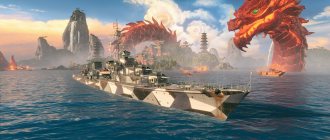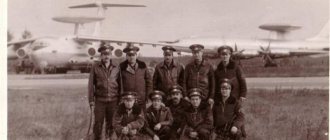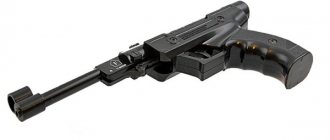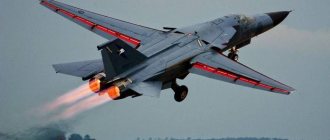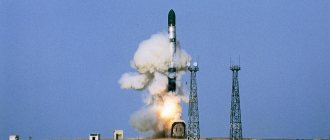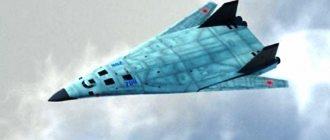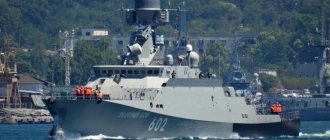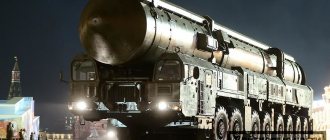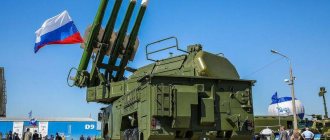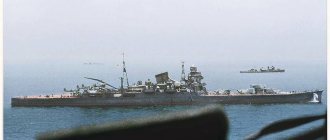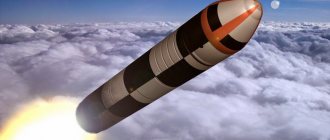At the beginning of World War II, American aviation had quite successful and modern B-17 and B-24 bombers. But already in 1943, it was possible to put into production an aircraft that was not only superior to its predecessors, but truly had no analogues among its competitors.
Usually in military conditions they do not master the production of equipment replete with non-standard solutions. The “superfortress” was not only mass-produced, but also managed to play a significant role in the war. And it opened a new page in the history of strategic aviation, becoming the first carrier of nuclear weapons.
Story
The B-17 bomber has not yet left the prototype stage, but they have already started developing more advanced aircraft. At first, this work was of a proactive nature, but in 1938 the Army Air Corps asked the company to modernize the B-17, equipping it with a pressurized cabin and landing gear with a nose gear. By this time, Boeing had already created a Stratoliner passenger aircraft with a pressurized cabin based on the Flying Fortress, so the designers had experience.
In 1939, the Army announced a competition to create a new “superbomber” capable of delivering 9 tons of bombs to a range of up to 4 thousand kilometers. Boeing, taking advantage of its developments, submitted the Model 345 aircraft project for consideration in the spring of 1940, and received an order for the production of flying prototypes. The aircraft were assigned the index XB-29.
In 1941, the manufacturer was already accepting an order to assemble a batch of 250 aircraft.
Assembly of the prototype, however, progressed slowly. The bomber was technologically complex, the design was full of innovative solutions. And the United States had already entered World War II, and production of the B-29 needed to be launched as quickly as possible.
The first unarmed B-29 did not fly until September 1942. The second prototype, equipped with machine gun mounts, took off in December, and suffered an engine fire on its first flight. And at the beginning of 1943, the plane crashed, killing the entire crew. However, in the same year, the first deliveries of production aircraft began.
B-29B
Dive bomber
Boeing B-29B-60-BA (S/N 44-84061) "Pacusan Dreamboat"
Section source: Baugher's Encyclopedia & National Museum of the USAF
The B-29B
was a modification used for low-level raids, designed with the intent of firebombing Japan. Since fighter opposition was minimal over Japan in late 1944, many of the Army Air Force leadership — most notably Curtis LeMay, commander of the XXI Bomber Command — felt that a (lighter) faster bomber would better evade Japanese flak.
In the B-29B, as with the atomic raid-dedicated versions earlier, all defensive armament was removed except for that in the tail turret. Initially the armament was two .50 in AN/M2 machine guns and one 20 mm M2 cannon which was soon changed to three .50 in AN/M2s. The weight saved by removing the guns increased the top speed from 357 mph to 364 mph (575 km/h to 586 km/h).
Also incorporated on this version was an improved APQ-7 “Eagle” bombing-through-overcast radar that was fitted in an airfoil-shaped radome under the fuselage.
All 311 B-29Bs were built at the Bell plant in Marietta, Georgia (“Bell-Atlanta”).
Design
The B-29 Superfortress heavy bomber was an all-metal, 4-engine mid-wing aircraft. The fuselage, round in cross-section, contained three pressurized cabins connected to each other by a sealed manhole. The front cockpit housed the pilots, radio operator, navigator and flight engineer. In the rear cabin there were gunners, and there was a rest area with bunks and a toilet. The small tail cabin was intended for the rear gunner.
Most modifications of the bomber were equipped with 18-cylinder R-3350 radial engines.
Since their development took place in wartime conditions, and the aircraft were in a hurry to be put into production, the initial power plant acquired a reputation as unreliable and fire hazardous. It was only after the war that the problems were finally resolved.
Protected fuel tanks were located in the wings, and additional ones could be hung in the bomb bay. The bomber was also equipped with an auxiliary power unit - a small-sized gasoline engine connected to a generator.
The hydraulic system on the “Superfortresses” was almost completely replaced by electric drives. For navigation and bombing, the B-29 used the AN/APQ-13 radar. Three cameras and a Norden bomb sight were installed as standard.
To provide the aircraft with powerful defensive weapons, while placing all the shooters in pressurized cabins, the designers used remote-controlled turrets with automatic adjustments to the sight and blockers that disable machine guns so as not to hit their aircraft. The turrets were equipped with up to four 12.7mm Browning M2 machine guns and a movie camera.
A fortress with wings – the Boeing B-29 “Superfortress” strategic bomber
The Boeing B-29 "Superfortress" is a four-engine strategic bomber. The B-29 Superfortress turned out to be the only American-made aircraft with a flight range that allowed attacks on Japanese territory. The release of the B-29 "Superfortress" was the largest production program for a single type of aircraft during World War II.
The development of the bomber was carried out in accordance with the R-40B specification, prepared in January 1940. The company's designers began developing an ultra-long-range bomber back in March 1938. Boeing has developed a number of preliminary designs, the best of which is the Model 341, a monoplane with a mid-wing, tricycle landing gear with a nose wheel, and air-cooled Pratt & Whitney R-2800 engines. It was this project that was presented to the customer. However, in March 1940, the specification was adjusted - the requirements for defensive weapons and bomb load increased. As a result, the new project - “model 345” - had 18-cylinder Wright R-3350 “Duplex Cyclone” air-cooled engines. Defensive weapons, consisting of 10 12.7 mm machine guns and a 20 mm cannon, were housed in four tail-mounted retractable turrets with remote control. The control system made it possible for any gunner (except the tail one) to control other installations. Thus, it became possible to transfer an enemy aircraft from the line of sight of one gunner to another, concentrating maximum fire on the enemy each time. The crew cabins are sealed. The usual hydraulic and pneumatic systems for driving most of the bomber's units were replaced with electric motors. In May 1940, the preliminary design was reviewed by the military, and in August Boeing received an order to produce two prototype aircraft. The vehicles were given the designation XB-29. Aircraft designer E. Bell led the detailed design. A total of $3 billion was invested in the program.
The XB-29 prototype, equipped with R-3350-13 engines, first flew on September 15, 1942. The tests were difficult - problems with the engines regularly arose. The most unlucky in this regard was the second prototype: during the first flight (December 30, 1942), one of its engines caught fire, and on February 18, 1943, the plane crashed. The cause of the disaster was a fire in the engine nacelle that spread to the fuel tank. Only on the third prototype (testing began in June 1943) was it possible to achieve trouble-free operation of the engines. This made it possible, based on Boeing's drawings, to begin production of a pre-production batch of YB-29 consisting of 14 aircraft. Pre-production bombers were equipped with R-3350-21 engines. The first of the YB-29s was ready in April 1943, but its first flight took place only in July, when it became clear that the tests of the third prototype were successful. At the end of August 1943, supplies of serial B-29s were established. The production of bombers was carried out by Martin and Bell. A colossal number of new enterprises were built for production - the main sections of the aircraft were produced by 60 enterprises. The total production volume was 3965 cars. Production was completed in May 1946.
B-29 bomber design
The Boeing B-29 “Superfortress” is a heavy four-engine bomber, all-metal, with working skin, designed according to the center section design. The airframe was assembled from aluminum sheets and profiles. Additionally, plexiglass, steel armor plates and bulletproof glass were used.
The fuselage, which had a circular cross-section and working skin, consisted of five parts. The round cross-section was given to ensure maximum mechanical strength and minimum aerodynamic drag. The fuselage structure used stringers, frames, auxiliary frames, reinforcing inserts and working skin, the sheets of which were laid end to end. The skin was attached to the load-bearing elements of the fuselage using rivets with countersunk heads. Bullhead rivets were used in the machine gun turret area to provide additional strength.
The tail is classic, cantilever. Stabilizers with load-bearing skin, ribs and spars. The direction and elevator rudders are covered with fabric.
The landing gear is retractable, three-post. The two main landing gear carried two wheels each and were equipped with two hydropneumatic shock absorbers. The front landing gear, which also has two wheels, was equipped with one hydropneumatic shock absorber. At the rear of the fuselage there was a crutch that was retractable in flight, protecting the rear lower turret. Electric motors were used to retract the landing gear. Cleaning took about 1 minute. The front strut was laid back, the main struts were laid up and forward. The brake system was hydraulically driven.
The fuselage of the B-29 Superfortress had three pressurized cabins. The front and rear cabins were connected by a tunnel with a diameter of 34 inches and a length of 33 feet. The tunnel allowed crew members to move between cabins. The bomber's crew consisted of 10–14 people. The standard crew included 10 people: crew commander, co-pilot, navigator, flight mechanic, bombardier, radio operator and four gunners. The front pressurized cabin served to accommodate both pilots, a navigator, a flight mechanic and a radio operator. The nose of the fuselage with significant glazing gave a good view to the pilots and bombardier.
The rear pressurized cabin housed three gunners. Also located here were the remote control systems for the turrets. The sighting devices were placed under transparent domes. There were two domes on the sides, and one in the upper part of the fuselage. Nearby there were four sun loungers used during the flight for rest of the crew. The rear cockpit also housed the radar operator, a possible eleventh crew member.
At the rear extreme point of the fuselage there was a small tail cabin for the tail gunner. All crew positions were protected from shrapnel and bullets.
The use of pressurized cabins simplified the work of crew members, protecting them from low pressure, noise, cold and drafts. It was possible to communicate in the cabin without using intercoms. The pressure was maintained by supercharging the internal engines. When approaching the target, the pressure in the pressurized cabins was released to prevent rupture in case of an accidental hit. When the pressurized cabins were turned off, oxygen masks were used.
The wings are cantilever, trapezoidal in shape with rounded tips, elevation 4.5 degrees, aspect ratio 11.5, trailing edge perpendicular to the fuselage, leading edge sweep 7 degrees.
The selection of the wing profile of heavy aircraft was carried out by the aerodynamic department even before the design of the B-29. A promising profile was created for the Boeing HRVV-1 Sea Ranger flying boat. It had a large thickness in the central part, and a concave surface at the trailing edge at the top and bottom. The high profile provided low aerodynamic drag and significant lift at high speeds. The high lift-to-drag ratio made it possible to reduce the wing area. At the same time, the wing had a significant elongation and a large span.
The wings structurally consisted of 5 parts: a center section, two consoles (with a landing gear, flaps and two engine nacelles) and two winglets. The load-bearing elements of each part are front and rear spars connected by ribs. On the B-29, the designers used rigid ribs. The wing frame was complemented by a leading edge truss. To fasten the sheathing made of duralumin sheets (placed end-to-end), rivets with a flat head were used. The front truss is removable for access to internal components.
The B-29 Superfortress was equipped with large Flower-Zapp slotted flaps mounted along the trailing edge. Metal-sheathed flaps ran from the fuselage to the aileron. The ailerons are covered with fabric, balanced dynamically and statically, equipped with valves and trimmers. The design of the wing, flaps and ailerons ensured a landing speed of only 160 km/h.
The total area of the wings was 1615 m2, and the mass was about 9980 kg.
The propulsion system of the B-29 strategic bomber consisted of 4 Wright-Cyclone R-3350 engines. The following engines were installed on various modifications of the aircraft: - R-3350-13 - on the prototype. Power 1618 kW/2200 hp at an altitude of 25 thousand feet (7620 m); - R-3350-23 - on the first production B-29s, also produced by the plant in Wichta. Starting power 1618 kW/2200 hp, combat power 1787 kW/2439 hp; - R-3350-41 - on the latest B-29 series. The characteristics have not changed; - R-3350-57 - on B-29A, produced in Renton. Combat power 1839 kW/2500 hp.
The XB-29 prototypes and pre-production YB-29 bombers were powered by three-bladed 5.18 m (17 ft) diameter Hamilton Standard Hydrometic propellers. The production B-29s were equipped with four-bladed Hamilton Standard propellers with a diameter of 5.05 m (16 ft 7 in) with a pitch variable over a wide range. To increase the reliability of the propeller and reduce its noise, the rotation speed was quite slow. Some B-29 and B-29B were equipped with Curtiss Electric propellers with an electric pitch control system. All screws changed pitch synchronously using a common regulator.
Each of the engines had an independent fuel supply. Four main fuel tanks were located between the spars in the wings. Fuel for the internal engines was placed in two tanks between the outer and inner engine nacelles. Tanks for external engines were located outside the outer engine nacelles. In the event of a hole in one of the tanks, the fuel was transferred to intact ones. The total fuel volume was 30,283 liters (8 thousand US gallons). Also in both bomb bays it was possible to install four (two in each) additional tanks.
Operating experience with the B-17 and B-24 showed that the hydraulic system has very low survivability, so they tried to eliminate it from the design as much as possible. As a result, on the B-29 bomber the hydraulic drive was left only on the landing gear brakes. The main aerodynamic rudders were controlled using classic rods. To increase reliability, all rods were duplicated. The trimmers were adjusted using electric motors.
The Superfortress's control system was atypical for strategic bombers. During the initial design phase of the B-29, designers were concerned that the large rudders would require significant effort from the pilot. The use of electric or hydraulic amplifiers was envisaged, but this complicated the design. The trimmers were positioned in such a way that they balanced the forces acting on the rudders, which eliminated amplifiers. To relieve pilots from excessive information, some instruments, mainly monitoring engine operation, were moved to a console near the flight mechanic's seat.
The design of the B-29 included de-icers; however, in combat situations they were often removed, since when damaged they disrupted the operation of the rudders, and were subsequently abandoned completely. The system returned to the B-29 after the war. These were modifications adapted for operation in the Arctic and some vehicles that took part in the Korean War.
The aircraft carried standard US Air Force radio and navigation equipment. The B-29 and B-29A were equipped with AN/APQ-13 radars that scan the surface of the earth. It was used for high-altitude bombing and navigation. The B-29B was equipped with the AN/APQ-7 Eagle radar, which was distinguished by its high resolution. Later, the B-29B was equipped with an AN/APQ-15B radar, which was coupled with a tail turret sight, to detect enemy aircraft in the rear hemisphere.
As standard, B-29 bombers were equipped with three cameras used during bombing. The cameras were installed between the tail and rear pressurized cabins in the rear fuselage. In addition, some crew members had K-20 hand-held cameras.
Armament of the B-29 "Superfortress"
The B-29 had two bombing compartments: front and rear, which were separated by a center section. Vertical racks with locks for bombs were mounted inside the compartments. Also, cargo containers or additional gas tanks could be attached to the racks.
Initially, bombers were equipped with electric drives for bomb bay doors. Electric motors, smoothly opening the doors, began to work as they approached the target. It took quite a lot of time to open the doors, and this allowed the enemy to get his bearings. In addition, the opening doors created a lot of resistance, causing noticeable vibrations. Therefore, in the process of mass production, the electric drive was replaced with a pneumatic one, which made it possible to reduce the plowing time to several seconds. At the same time, the pneumatic drive of the bomb bay doors sharply swinging open on the ground could cause serious injuries to a person standing near them. Therefore, on the ground, the bomb bay doors were kept constantly open.
The B-29 Superfortress aircraft could accept the following types of bombs: - general-purpose high-explosive bombs weighing from 45 to 1814 kg (100 to 4000 lb); — incendiary bombs M52 (weight 0.9 kg, 2 pounds), M50 (weight 1.8 kg, 4 pounds), M69 (weight 3 kg, 6 pounds) combined into cassettes; - separate heavy incendiary bombs M47A2 (weight 45 kg, 100 pounds) and M76 (weight 227 kg, 500 pounds); - M81 fragmentation bombs (weight 118 kg, 260 pounds) and Ml, M26 cassettes consisting of M41 fragmentation bombs (weight 9 kg, 20 pounds). As a rule, they were added to the main ammunition load of incendiary or high-explosive bombs; - sea mines weighing 454 or 907 kg (1000 or 2000 lb). Usually 5,443 or 6,350 kg (12,000 or 14,000 lb) min were taken on board. The mines were laid from a height of 2,400 m (8,000 ft).
The standard bomb load of the B-29 Superfortress bomber ranged from 3,628 to 9,072 kg (8,000 to 20,000 lb).
The aircraft was equipped with a Norden M optical bomb sight, which was considered secret throughout most of World War II. The sight had a complex device that made it possible to take into account the ballistics of an aerial bomb and various corrections. The bombs were dropped automatically, at a certain point in time. The sight and autopilot were linked, which made it possible for the bombardier to take control of the aircraft during bombing.
During the war, the B-29's defensive weapons were very powerful. When designing, the designers proceeded from the fact that the long-range bomber would operate without fighter escort, so it would need to independently repel enemy attacks. The machine gun armament of the B-29 bomber did not leave any dead zones around the aircraft. At the same time, the designers were faced with another problem - the shooters had to be placed in pressurized cabins, which excluded the use of classic turrets serviced by the shooter from the inside.
A way out of this situation was found in the use of remotely controlled turrets. The turret control system was developed by . It used small electric motors that aimed machine guns according to the readings of a sight installed in the pressurized cabin.
The aircraft was equipped with four turrets: two on the top and two on the bottom of the fuselage. Another one was installed in the tail. The bombardier controlled the front turrets. The side gunners controlled the rear lower turret. The gunner served the upper rear turret in the central firing post. The tail installation was serviced by the tail gunner. In addition, it was possible to control the turrets from other posts - 24 control combinations were provided.
The shooters aimed the aiming device at the target. The automatic system set the necessary corrections for parallax, wind direction and strength, and gravity, and rotated the turret. The descent was also carried out remotely. The remote fire control system used on the B-29 became a new word in aviation, far ahead of its time.
The turrets were equipped with blockers that did not allow them to shoot through their aircraft. Since the keel was large, the machine guns were turned off the moment they turned towards it. During takeoff/landing, the front lower turret was deployed with its barrels backwards, since it blocked the front landing gear, and during bombing, it was deployed with machine guns forward, so as not to block the front bomb bay. During takeoff/landing, the machine guns of the rear lower turret turned back and rose up all the way.
Initially, the turrets were equipped with two Browning M-2 machine guns of 12.7 mm caliber. Since Japanese and German fighters quite often launched a frontal attack, the number of machine guns in the upper front turret was increased to four. A four-machine gun turret from the Northrop P-61 Black Widow fighter was used, but adapted for the B-29. Initially, the ammunition load included 500 rounds per barrel, then it was increased to 1000, but towards the end of the war it was again reduced to 500.
The first B-29 bombers had, in addition to a pair of machine guns in the tail mount, an M-2B 20 mm cannon. Ammunition for the machine guns was placed in a large container outside the pressurized cabin. The gun's ammunition capacity is 110 rounds. Cannon fire could be fired separately or in a salvo with machine guns. However, due to the different trajectories of shells and bullets, salvo fire was practically not used. Soon they stopped installing the cannon.
A 16-mm movie camera was installed in each of the turrets, which turned on simultaneously with the machine guns and turned off after a ceasefire three seconds later.
Combat use of the Boeing B-29 “Superfortress”
The history of the combat use of the Boeing B-29 “Superfortress” is quite extensive and one can talk about it endlessly. Entire books are devoted to this topic. This is explained by the fact that this strategic bomber was one of the most popular aircraft of its class - at the end of World War II, more than 2,000 aircraft were in service, and over the entire production period, more than 3,000 aircraft were built. Here are just some of the most significant facts from the history of the combat use of the Boeing B-29 “Superfortress”.
The first to master the new B-29 bombers were the crews of the 58th Bombardment Wing, which included 4 groups. By January 1944, the Superfortress piloting technique had been mastered, and testing for its combat use began. First of all, the B-29s were to be used against Japan - the use of new bombers in Europe was not intended; for these theaters of war, the B-17 and B-24 were quite sufficient. Superfortress formations based on Indian territory were supposed to use Chinese jump airfields, which made it possible to destroy targets on the Japanese islands.
The first B-29s arrived in India in April 1944, and the first combat flight of 98 bombers took place on June 5. Their target was a railway junction near Bangkok. The results of this flight were catastrophic - 14 aircraft returned to their bases due to engine malfunctions; upon return, 42 had to land at alternate airfields because they ran out of fuel; another 5 aircraft crashed during landing. Only 18 bombs fell near the target. The second flight, which took place on June 14, brought even less results: out of 75 bombers, 18 aircraft did not complete the mission for various reasons, 1 crashed during take-off, 6 during landing, 1 was destroyed by anti-aircraft guns. The target, a metallurgical plant on the island of Kyushu, was hit by only one bomb. In the following months, Superfortress bombed factories, oil refineries and other objects in Japan - the result of all sorties was meager. The situation changed on August 29, 1944 after the appointment of General K. Lemay to the post of commander of the 20th Air Force, which united B-29 units. He managed to quickly restructure the combat operation of the bombers. As a result of B-29 Superfortress raids on targets in Manchuria in September 1944, industrial production there was reduced by 30%. The last large-scale "Superfortress" operation using airfields in China, which were difficult to supply, was the December 18, 1944 strikes against Japanese troops near Hankow. Then the bombers took off from Indian airfields. They were used to bomb the docks of Singapore, mine the Yellow and Yangtze rivers, and the waters off Saigon. On March 29, 1945, the last raid from Indian territory took place.
American Boeing B-29s have been operating from a base on the island of Saipan since October 1944. The 73rd Airlift Wing relocated there. By the end of the month, the number of “Superfortresses” had already reached 100 units. The first combat flight from this base took place on October 28. The target was the Japanese naval base on Truk Atoll. A month later, on November 24, the planes were already working on targets on the Japanese islands - aircraft factories near Tokyo. Subsequently, such raids became systematic, but it was not possible to immediately achieve good results - as a rule, strikes were carried out from a height of 8-9 thousand meters with poor visibility, and therefore most of the bombs did not hit the targets. The first successful raid can be considered a raid on an engine plant in Nagoya on December 13, 1944. As a result of the airstrike, aircraft production in Japan was reduced by approximately 25%. The capture of the island of Iwo Jima, located approximately halfway from the Mariana Islands to Japan, in December 1944 made it possible to organize escort of B-29s by P-51D fighters.
B-29 formations changed tactics in January 1945: now strikes were carried out primarily at night from medium altitudes using incendiary bombs. On January 3, this tactic was tested during a raid on Nagoya. On February 4, a massive attack was launched on Kobe - in addition to the 73rd wing, a squadron of the 313th wing took part in the airstrike. Soon the 314th Airlift Wing was transferred to Guam. The scope of combat operations using the Boeing B-29 “Superfortress” was constantly increasing. The March 9 raid on Tokyo involved 325 B-29s, which dropped a total of 1,665 tons of incendiary bombs. This strike also saw the first use of napalm. About 150 thousand people died, more than a million lost their homes. Losses on the American side amounted to 14 aircraft. The next day, Nagoya was attacked, then Osaka.
In April 1945, the 58th Wing arrived in the Mariana Islands from India, and the 315th Wing, armed with B-29Bs, was transferred from the United States. Now the American Air Force could use 700 “Superfortresses” against Japan. Now aircraft were used not only for attacks on cities, but also for other tasks. Back in March, in preparation for the landing on Okinawa, B-29 bombers carried out massive attacks on enemy airfields. The 315th Airlift Wing was primarily engaged in the destruction of oil refineries and oil storage facilities, and the 313th in laying mines in the coastal waters of Japan. About 13,000 acoustic mines were delivered.
The Boeing B-29 Superfortress became the first (and only) aircraft to use nuclear weapons in combat conditions. For this purpose, the 509th Mixed Air Group was formed in December 1944. It consisted of 15 B-29 “Superfortresses”, adapted to drop atomic bombs. After training with the release of large-scale mock-ups on American soil, the squadron was redeployed to Tinian in April 1945. On August 6, planes of this unit dropped an atomic bomb on Hiroshima, and on August 9 on Nagasaki. As a result of the first airstrike, 129 thousand people were hit, of which 78 thousand were fatal. The destruction caused was equivalent to a 2 thousand Superfortress raid. In Nagasaki, about 35 thousand people were killed, 60 thousand were injured. In parallel with nuclear strikes, conventional bombings continued. August 14 is the last day of mass raids on Japanese territory. On this day, approximately 740 B-29 Superfortresses carried out the attack.
After the end of World War II, the B-29 Superfortress became the basis of the Strategic Air Command, formed in March 1946. Initially, it consisted of 14 groups armed with B-29s. In addition to the United States, these aircraft were based in Great Britain. The replacement of the B-29 by the B-50 bomber (a further development of the "Superfortress") began in 1949. In 1950-1953, B-29 bombers were used in the Korean War, after which they were removed from service with combat units.
Wreckage of a B-29 shot down on November 9, 1950 by Soviet MiG-15s
84 Boeing B-29A and 3 Boeing RB-29A were transferred to Great Britain in 1950, where they were designated “Washington” B Mk.1. were in use until 1955.
In 1944, three B-29 bombers made emergency landings on the territory of the USSR and fell into the hands of Soviet specialists. Having undergone extensive research and testing, they served as a model for the Tu-4 strategic bomber.
Only the bold decision to begin a production program involving many enterprises long before the B-29 made its first flight made it possible to make a major contribution to victory in the war. By the time Japan surrendered, more than 2,000 aircraft were in service, and although the order for 5,000 aircraft was canceled the next day, the production program was gradually curtailed until May 1946. By this time, 3,960 B-29s had been built. Many were modified for a variety of missions, and some began careers as tankers, flying laboratories for turbojet engine debugging, or maritime rescue aircraft. Some took another 10 years to fly.
Variants and modifications of the B-29 "Superfortress"
XB-29 - prototypes equipped with R-3350-13 engines with three-bladed propellers. Three vehicles were built, as well as one airframe intended for static testing. YB-29 – 14 pre-production aircraft intended for military testing with weapons. They were equipped with R-3350-21 engines with four-blade propellers. B-29 is the main serial modification. The production was carried out by Bell and Martin. Equipped with 2200-horsepower R-3350-23, -23A or -41. Later aircraft were equipped with R-3350-41 or -57 engines with the same power, but with increased reliability. The tail gun mount has three barrels: in one version there are three 12.7 mm machine guns, in the second version there is one 20 mm cannon and two machine guns. B-29A is a serial modification built in Renton. The wingspan was increased to 43.36 m. Equipped with an R-3350-57, -57A or -59 engine. The front upper machine gun turret is four-barreled. 1119 cars were produced. TV-29A is a variant of the B-29A intended for training. ETV-29A – carrier of EF-84E fighters. The fighters were mounted on the wing consoles. The B-29B is a production aircraft built by Bell. Equipped with R-3350-51 engines. The defensive weapons were completely dismantled with the exception of the tail turret. Bomb load - up to 10340 kg. 310 cars were produced. EB-29B is the carrier of the XF-85 Goblin fighter. B-29C - this project was supposed to use the latest modification of the R-3350 engine, but due to the end of World War II, the order for 5,000 aircraft was canceled. B-29D – modification with R-4360-35 engines and an enlarged keel. Subsequently received the designation B-50. XB-29E - intended for testing weapon control systems. The B-29F is a lightweight version equipped for service in Alaska. Intended to carry out reconnaissance flights over the USSR. 6 planes. The XB-29G is a flying engine test laboratory. ХВ-29Н - intended for weapons testing. YB-29J - had modified engine nacelles and was intended for engine testing. The RB-29J is a reconnaissance aircraft, also known as the FB-29J. YKB-29J - equipped with a Boeing fuel refueling boom. CB-29J is a transport aircraft. KV-29M is a tanker with a towed cone. B-29MR is an aircraft equipped with receiving refueling equipment. KV-29R is a tanker aircraft with a rigid boom. YKB-29T is a tanker aircraft with three refueling nodes. DB-29 – UAV control center. GB-29 – carrier of the X-1 and other experimental vehicles. QB-29 – radio-controlled target. SB-29 - rescue aircraft with a lifeboat drop. 16 vehicles were modernized. WB-29 - weather reconnaissance aircraft. XB-39 is a modification of YB-29 equipped with a V-3420-11 engine. XB-44 - also known as XB-29D. Served as the prototype for the B-50. Equipped with an R-4360-33 engine. Defensive armament was limited to two tail cannons. F-13A - strategic photo reconnaissance aircraft. In 1945, renamed FB-29A, and later RB-29A. Later it was converted to conduct electronic reconnaissance. 117 vehicles were converted. TF-13A – F-13A trainer. Р2В-1S – radar patrol aircraft. A large radar and additional fuel were located in the bomb bay. P2B-2S - P2B-1S with modified and modernized equipment. Later they were used to launch experimental aircraft.
Flight characteristics of the B-29 Superfortress: Crew - 11 people; Length – 30.18 m; Wing span – 43.05 m; Height – 9.02 m; Wing area – 161.27 m2; Wing profile – Boeing 117; Leading edge sweep – 7°1'26; Wing aspect ratio – 11.5; Average aerodynamic chord – 3.92 m; Wing load – 397.4 kg/m2; Chassis track – 8.69 m; Fuel tank capacity – 35443 l; Fuel mass in internal tanks – 25482 kg; Empty weight – 31815 kg; Curb weight – 36652 kg; Weight in combat - 45926 kg; Maximum take-off weight – 56245 kg; Equivalent resistance area – 3.82 m2; Drag coefficient – 0.0241; Propeller – Hamilton Std 6526A-6; Screw diameter – 5.05 m; Power plant 4xR-3350-23-23A/41 “Cyclone” Power – 4x2200 hp (4x1640 kW); Maximum speed – 576 km/h at an altitude of 7620 m; Stall speed – 191 km/h; Cruising speed – 370 km/h; Combat radius - 3413 km; Combat radius with maximum combat load – 2715 km; Flight range – 5230 km; Ferry range (without bombs) – 8321 km; Service ceiling – 12070 m; Working ceiling – 9710 m; Rate of climb – 8.26 m/s; Climb time 3048 m – 23.5 minutes; Climb time 6096 m – 61.5 minutes; Run length – 1594 m; Run length – 680 m; Aerodynamic quality – 6.8; Armament: Bomb load – 9072 kg; Guns – 1x20 mm; Machine guns – 7x12.7 mm.
Prepared from materials: pro-samolet.ru www.airaces.ru www.airwar.ru www.brazd.ru www.nnre.ru
Exploitation
Initial plans for the use of the B-29 envisaged that the aircraft would bomb Nazi Germany, taking off from airfields in Egypt. However, the difficulties of mastering the “Superfortresses” adjusted these plans, and the B-29s never made it to Europe. They began arriving in India in the spring of 1944, and in June they flew their first combat mission, attacking Japanese targets in Thailand. 10 days after this, the first raid on the Japanese islands took place.
The use of bombers from bases in China was logistically difficult - there were no land routes to China, and all supplies had to be transported to the airfield on the B-29s themselves. In addition, the planes could only attack a small part of Japan. New airfields began to be built on the reclaimed Mariana Islands.
The first B-29s began arriving on Saipan in the fall of 1944, and combat missions began in late October. The bombing of Japan reached its peak on March 9, 1945 - 279 “Superfortresses” leveled the eastern regions of Tokyo, with only 14 vehicles lost.
In August 1945, B-29s carried out two bombing missions that forever etched the aircraft in history.
On August 6, the Enola Gay, piloted by Colonel Tibbetts, dropped a nuclear bomb on Hiroshima. On August 9, Major Sweeney's B-29 "Bockscar" dropped a second bomb on Nagasaki. The ethics and appropriateness of these missions are still debated to this day. One thing is indisputable: a huge number of civilians died in the cities, and later died a terrible death.
On the other hand, the Japanese themselves are not angels either; in the Nanking Massacre they were able to brutally exterminate hundreds of thousands of citizens without the help of nuclear weapons. And how great the number of any casualties would be if troops had to be landed in Japan - one can only guess.
After Japan's surrender, B-29s dropped food supplies into Japanese prison camps. After World War II, many “Superfortresses” were sent into storage, but some became part of the fleet of the newly created Strategic Air Command. Moreover, following the adoption of the B-36 aircraft, the B-29 was reclassified as a medium-range bomber.
Since 1950, B-29s have been used to bomb Korea.
At first they flew during the day, but soon began to suffer losses from collisions with jet fighters. To reduce losses, operations began to be carried out only at night. From the mid-50s, the “Superfortresses” began to be decommissioned, and the latter, which served as fuel tankers and weather reconnaissance ships, served until the mid-60s.
World War IIIdit
The initial plan, implemented in the direction of President Roosevelt as a promise to China and called Operation Matterhorn, was to use B-29s to attack Japan from four forward bases in Guangxi, Southern China, with five main bases in Bangladesh, India, and to attack other targets in the region from China and India as needed.
The Chengdu region was eventually chosen over the Guilin region to avoid having to raise, equip, and train fifty Chinese divisions to protect the advanced bases from Japanese ground attack. The XX Bomber Command, initially intended to be two combat wings of four groups each, was reduced to a single wing of four groups because of the lack of availability of aircraft, automatically limiting the effectiveness of any attacks from China. This was an extremely costly scheme, as there was no overland connection available between India and China, and all the supplies had to be flown over the Himalayas. B-29s started to arrive in India in early April 1944. The first B-29 flight to airfields in China (over the Himalayas, or “The Hump”) took place on 24 April 1944. The first B-29 combat mission was flown on 5 June,1944, with 77 out of 98 planes launched from India bombing the railroad shops in Bangkok (Five B-29s were lost to non-combat causes).
The need to use inconvenient bases in China for attacks against Japan ceased after the capture of the Marianas islands in 1944. On the islands of Tinian, Saipan and Guam five major airfields, each constructed as a base for a four-group wing of B- 29s, became the launch sites for the large B-29 raids against Japan in the final year of the war. The islands could be easily supplied by ship. The first B-29 arrived on Saipan on October 12, 1944, and the first combat mission was launched from there on October 28, 1944, with 14 B-29s attacking the Truk atoll. The first mission against Japan from bases in the Marianas was flown on November 24, 1944, with 111 B-29s sent to attack Tokyo. From that point, ever more intense raids were launched regularly until the end of the war. These attacks succeeded in devastating all large Japanese cities (with the exception of Kyoto) and gravely damaged Japan's war industries. Although less appreciated, the aerial mining program carried out by B-29s against Japanese shipping routes and harbor approaches had profoundly degraded Japan's ability to support its population and fight the war.
Enola Gay
Enola Gay
The B-29 was used in World War II only in the Pacific Theatre.
Korean Conflict and Postwar ServiceEdit
The B-29 was later used in the Korean War. At first, the bomber was used in normal strategic daylight bombing missions, though North Korea's few strategic targets and industries were quickly reduced to rubble. More importantly, in 1950 numbers of Soviet MiG-15 'Fagot' jet fighters appeared over Korea (a plane specifically designed to shoot down the B-29), and after the loss of several aircraft, future B-29 raids were restricted to night -only missions, largely in an interdictive role. Over the course of the war, B-29s flew 20,000 sorties and dropped 200,000 tons (180,000 tons) of bombs. B-29 gunners were credited with shooting down 27 enemy aircraft.
Modifications
The first prototypes of the aircraft, built in 1942, were designated XB-29. The pre-production batch of 14 copies received the index YB-29. They differed from the prototypes in their uprated engines, four-blade propellers, and modified weapons.
The first production series of bombers was simply called B-29 and had no additional letter designations. The B-29A's defensive armament was strengthened and the wing design was changed to simplify assembly.
Lightened by the removal of defensive machine guns and armor, the B-29B was used for night raids on Japan. Another difference was the use of the AN/APQ-7 radar, with a narrow field of view but high resolution. It was planned to install new engines for the modification of the B-29C bomber, but after the end of the war the order was completely canceled.
The B-29D variant featured R-4360 engines with 3,500 hp. each, and a reinforced tail unit.
Its development was completed only after the war, and put into production under the guise of the new B-50 Superfortress aircraft. The “fiftieth” was not used in combat for its “bomber” purpose; only its reconnaissance modification reached the front of the Korean War. But it was the “fifties” that became the last “Superfortresses” removed from service.
The KB-29 model became one of the first refueling aircraft. The EB-29 modification was used to launch experimental aircraft. The RB-29 was a reconnaissance aircraft adapted for aerial photography, and the WB-29 was a weather reconnaissance aircraft.
The bombers, converted into carriers of nuclear weapons, belonged to the B-29 batch and were not allocated to a separate series (received, however, the code designation “Silverplate”). Their bomb bays were redone and machine gun armament was removed.
B-29A
Section source: Baugher
Boeing 767 300 interior diagram
Boeing B-29A-70-BN (S/N 44-62305). Note the streamlined top turret added on block 40 A models and later.
The B-29A
was an improved version of the original B-29 production model. This is the definitive wartime variant of the B-29. All 1,119 B-29A's were built at the Boeing plant in Renton, Washington, formerly used by the United States Navy.
Enhancements made in the B-29A included a better wing design and defensive modifications. Due to a demonstrated weakness to head-on fighter attacks, the number of machine guns in the forward dorsal turrets was doubled to four. Where the wings of previous models had been made by the sub-assembly of two sections, the B-29A wing was built up from three. This made construction easier, and increased the strength of the airframe. The B-29A was produced until May 1946, when the last aircraft was completed. It was much used during the Korean War, but was quickly phased out when the jet bomber (B-47 Stratojet) became operational.
Washington B Mk 1
– This was the service name given to 88 B-29As supplied to the Royal Air Force.
Flight performance
The B-29 was the most advanced heavy bomber in the 1940s. Not a single aircraft created before the war could compete with it, and after the war, piston engines were already replaced by jet engines. In the Royal Air Force, before the adoption of jet bombers, they used leased “Superfortresses”, and in the USSR the B-29 was simply copied (converted to metric units) and produced as the Tu-4.
| B-17G Flying Fortress | B-29 Superfortress | |
| Combat load, kg | 2300 (normal), 7800 (overload) | 4546 (normal), 9072 (maximum) |
| Cruising speed, km/h | 293 | 467 |
| Combat radius, km | 3219 | 3413 |
| Ceiling, m | 10850 | 12070 |
Even the basic modification of the Superfortress was head and shoulders above the most advanced B-17. The normal bomb load has almost doubled, cruising speed has increased significantly, navigation and sighting equipment have been supplemented with radar. Sealed cabins improved working conditions for the crew.
The fact that countries with strategic aviation used variants of the B-29 before the mass transition to jet aircraft suggests that it was also the best piston-engined bomber.
Of course, in America they will still create and use the titanic B-36, but this will be an attempt to create a strategic aircraft of a new era, using old technologies. The “Superfortress,” while remaining the aircraft of its time, was good enough to meet the beginning of the jet age.
Translation of "twenty nine" into other languages
Azerbaijani iyirmi doqquz Albanian 29 English twenty nine Arabic تسعة وعشرين Armenian քսան ինը Belarusian twenty dzevyats Bulgarian twenty nine Vietnamese hai mươi chín Dutch negenentwintig Greek ει κοσιεννέα Georgian ოცდაცხრა Hebrew עשרים ותשע Yiddish 29 Irish fiche a naoi Icelandic Tuttugu og níu Spanish veintinueve Italian ventinove Chinese 29 Korean 스물아홉 Latin et viginti novem, Latvian 29 Lithuanian 29 Mongolian horin esөn German neunundzwanzig Norwegian tjueni Persian 29 Polish dwadzieścia dziewięć Portuguese vinte e nove Romanian douăzeci și nouă Serbian dwades et devet Slovak dvadsať deväť Slovenian devetindvajset Thai 29 Turkish ilk yirmi dokuz Ukrainian twenty maidens' yat Finnish kaksikymmentäyhdeksän French vingt-neuf Croatian dvadesetdevet Czech dvacet devět Swedish tjugo nio Esperanto dudek naŭ Estonian TWENTY NINE Välja Japanese 29
YB-29
Boeing YB-29-BO (S/N 41-36957). Note the nose has an Erco ball turret with twin .50-cal. machine guns, and the fuselage package guns just below and aft of the cockpit have twin .50-cal. machine guns mounted.
The YB-29
was an improved XB-29 and 14 were built for service testing. Testing began in the summer of 1943, and dozens of modifications were made to the planes. The engines were upgraded from Wright R-3350-13s to R-3350-21s. Where the XB-29 had three-bladed props, the YB-29 had four-bladed propellers. Various alternatives to the remote-controlled defensive systems were tested on a number of them, particularly the fourth one delivered. After alternative arrangements had been fully tested, defensive armament was standardized at ten .50-caliber machine guns in turret-mounted pairs. The YB-29 also featured a better fire control system.
WB-29
Boeing WB-29A of the 53d Weather Reconnaissance Squadron in 1954
The WB-29
s were production aircraft modified to perform weather monitoring missions. An observation position was fitted above the central fuselage section. They conducted standard data-gathering flights, including from the UK over the Atlantic. They were also used to fly into the eye of a hurricane or typhoon to gather information. Following nuclear weapons tests, some WB-29s used air sampling scoops to test radiation levels. On 3 September 1949, a WB-29 returning from Yokota AB, Japan, to Eielson AFB, Alaska, recovered radioactive debris in air sampling scoops from the cloud generated by the first atomic bomb test by the Soviet Union on 29 August.
Armaments
Suspended armament
Main articles
:
AN-M64A1 (500 lb)
,
AN-M65A1 (1,000 lb)
,
AN-M66A2 (2,000 lb)
The B-29A-BN
can be outfitted with the following ordinance:
- 20 x 500 lb AN-M64A1 bombs (10,000 lb total)
- 40 x 500 lb AN-M64A1 bombs (20,000 lb total)
- 18 x 1000 lb AN-M65A1 bombs (18,000 lb total)
- 8 x 2000 lb AN-M66A2 bombs (16,000 lb total)
One might say the B-29A-BN is effectively a dump truck which can dump a ton of explosives, no make that upwards of 10 tons of explosives upon enemy targets. Utilizing speed at higher altitudes, it is the purpose of the Superfortress to race to an enemy base or ground targets and just rain down TNT. With three choices of bomb weights to choose from and four different configurations, there is no shortage of ways to destroy ground targets. The 1,000 lb and 2,000 lb bombs come in most handy for base bombing as they do the most amount of damage for the least amount of effort in a concentrated area. Area of denial is the specialty of the 500 lb bombs when used in carpet bombing operations. Carpet bombing is effectively laying down many of the 500 lb bombs at one time over an area where vehicles such as trucks, tanks and anti-aircraft vehicles or hardened structures such as pillboxes or anti-aircraft artillery may be located at. Since vehicles are on the move, dropping multiple bombs at a time making it more difficult for them to move out of the way and avoid the inbound ordnance.
With the B-29A-BN, there is no real overkill with the bombs, which can make the Superfortress a prime target to be eliminated early as with upwards of 20,000 lbs in bombs, the B-29A-BN can make short work of enemy bases and end the match earlier than most will expect.
Defensive armor
Main article
:
Browning M2 (12.7 mm)
The B-29A-BN
is defended by:
- 2 x 12.7 mm Browning M2 machine guns, tail turret (550 rpg = 1,100 total)
- 2 x 12.7 mm Browning M2 machine guns, rear ventral turret (575 rpg = 1,150 total)
- 2 x 12.7 mm Browning M2 machine guns, rear dorsal turret (500 rpg = 1,000 total)
- 2 x 12.7 mm Browning M2 machine guns, front ventral turret (500 rpg = 1,000 total)
- 4 x 12.7 mm Browning M2 machine guns, front dorsal turret (400 rpg = 1,600 total)
The B-29A-BN is defended by an impressive 12 x .50 caliber Browning machine guns rivaled only by the Blohm & Voss BV 238, Tupolev Tu-4, Consolidated PB4Y-2 and B-24 and the Boeing B-17. Typically when bombers add more guns, they had to add more crew to operate them which increased the overall weight of the aircraft, though ensuring more protection, it also reduced the amount of fuel or bombs which could be carried.
As a historical note, the advent of early analogue computers which were outfitted on the B-29A-BN and the state-of-the-art General Electric Central Fire Control System allowed for remote operation of both dorsal and both ventral turrets along with the tail gun if needed. The turrets could be linked through the fire control system and allow one gunner to operate multiple guns at one time. Simplifying this process and allowing gunners from just about anywhere on the aircraft to control the turrets reduced the number of crew members needed to operate the aircraft. Though four times the size of a B-25, the B-29A-BN operated efficiently on the same amount of crew members, seven.
The computer-aided turrets allowed for more accuracy when firing and can train the guns in just about any direction needed to combat incoming fighters. The tail gunner position is especially deadly as a fighter perched on the tail will be flying into the oncoming bullets from the tail gun position, thereby taking more damage when hit and more likely to take on a critical hit or disabling blow. Though not totally invulnerable to the crafty fighter pilot, the B-29A-BN in its own right is a porcupine with sharp quills pointing in all directions which will make it as difficult as possible for anyone to get past the defenses.
General info
Flight Performance
The B-29A-BN, much like its contemporaries the Messerschmitt Me 264, Blohm & Voss BV 238 and Tupolev Tu-4 was built for the sole purpose of flying high and dropping large amounts of bombs. To account for these characteristics, others such as manoeuvrability, rate-of-climb and acceleration were compromised. The B-29 is a heavy aircraft which when adding 10,000 – 20,000 lbs of ordnance will only make the plane that much more difficult to get to altitude, but once there this aircraft does have a decent cruising speed. To help speed up gameplay for this aircraft, it is given an air-start at the beginning of matches and also after landing to reload and repair due to its sheer size and difficulty climbing to its bombing altitude.
The typical method of utilizing this bomber is to fly the aircraft to a higher altitude. Depending on the enemy fighters, attackers and interceptors which appear in the match, you may be able to stay lower around 20,000 ft (6,000 m) or you may need to increase closer to 30,000 ft (9,150 m) to make it extremely difficult for the fighters to follow you up and many if they do get that high, their engines are struggling to keep the plane above stall speed which provides you with the opportunity to leave them behind or to easily pick them off with your gunners.
One downside to flying at the higher altitudes in arcade battles is that if you bomb a base but don't completely destroy it, it is difficult to circle back around and bomb again when the bombs have reloaded. A wide circle is necessary to accomplish this and it may be better and more efficient instead to fly towards another base, bomb it and turn around and finish off the first base. Another option too is to leave the partially bombed bases for the smaller and slower bombers on your team to finish off or just catch the partially bombed bases on a return pass.
| Characteristics | |||||||
| Stock | |||||||
| Max Speed(km/h at 9,100 m) | Max altitude(meters) | Turn time(seconds) | Rate of climb(meters/second) | Take-off run(meters) | |||
| AB | R.B. | AB | R.B. | AB | R.B. | ||
| 613 | 602 | 12 000 | 33.5 | 34.4 | 2.9 | 4.2 | 1,800 |
| Upgraded | |||||||
| Max Speed(km/h at 9,100 m) | Max altitude (meters) | Turn time (seconds) | Rate of climb(meters/second) | Take-off run (meters) | |||
| AB | R.B. | AB | R.B. | AB | R.B. | ||
| 669 | 641 | 12 000 | 30.7 | 32.0 | 11.7 | 6.5 | 1,800 |
Details
| Features | ||||
| Combat flap | Take-off flap | Landing flap | Air brakes | Arrest gear |
| ✓ | ✓ | ✓ | X | X |
| Limits | ||||
| Wing-break speed(km/h) | Gear limit(km/h) | Combat flap (km/h) | Max Static G | |
| + | — | |||
| 609 | 389 | 340 | ~1 | ~1 |
| Optimal velocities | |||
| Ailerons(km/h) | Rudder(km/h) | Elevators(km/h) | Radiator(km/h) |
| < 340 | < 350 | < 290 | > 400 |
| Compressor (RB/SB) | ||
| Setting 1 | ||
| Optimal altitude | 100% Engine power | WEP Engine power |
| 9,720 m | 2,200 hp | 2,499 hp |
Engine performance
| Engine | ||
| Engine Name | Number present | |
| Wright R-3350-57 18-cylinder | 4 | |
| Engine characteristics | ||
| Weight (each) | Type | Cooling |
| 1,251 kg | Radial | Air |
| Engine power (Stock) | ||
| Max | Take-off | |
| 1,975 hp | 2,276 hp | |
| Engine power (Upgraded) | ||
| Max | Take-off | |
| 2,200 hp | 2,502 hp |
Survivability and armor
- 60 mm Bulletproof glass in front of the pilots.
- 6.5 mm Steel plates in front of the pilots.
- 6.5 mm Steel plates behind the pilots.
- 6.5 mm Steel plates in front of tail control tractions.
- 6.5 mm Steel plates boxing around rear dorsal gunner and beam gunners.
- 6.5 mm Steel plate behind the rear ventral gunner.
- 60 mm Bulletproof glass in front of tail gunner.
- 6.5 mm Steel plate in front of tail gunner.
The B-29A-BN had to be judicious when it came to providing protecting armor for the aircrew at the sacrifice of additional fuel or ordnance. In fact, later models removed many of their defensive turrets in order to allow for more fuel and ordnance to be loaded. It is obvious that an aircraft this size will be a huge target for enemy fighters to attack with the nose section ( cockpit
) and the tail turret being the two most likely targets (
head-on attack and tail approach
) and thus both areas were equipped with 60 mm bulletproof glass which helps against lower caliber weapons, however 20 mm and above make short work of the bulletproof glass 6.5 mm steel plates are scattered around the aircraft to provide protection for both the crew members and some of the control surface linkages. Though not a stop-all invincible shield for the crew, it many instances it provided enough protection to allow crew members to survive and fight another day.
Notes
- .
- ↑, p. 24, 25.
- V. Ilyin, M. Levin.
Bombers. — M.: Victoria; AST, 1996. - P. 65. - .
- Igor Seydov. "Red Devils" in the skies of Korea. - M.: Yauza; Eksmo, 2007. - P. 676
- Magazine: “Wings and Homelands”, No. 1. 1989 L. Kerber, M. Saukke. Article: “Not a copy, but an analogue.”
- ↑ Magazine: “Aviation and Cosmonautics”, No. 9. 2001. V. Rigmant. Article: “Meeting America.”
- ↑ Magazine: “Wings of the Motherland” No. 10. 1998 V. Kotelnikov, D. Sobolev. Article about the Boeing B-29 aircraft: “Superfortress in the Soviet Union.”
- Magazine: “Aviation and Time”, No. 5. 1996. Monograph dedicated to the Tu-4 aircraft: “Made in the USSR.”
- see the story in the TV show from the Aviators series on the Discovery World channel
Who said you need defensive weapons?
The Ar 234 B-2 is an early jet bomber available in the German Aviation Research Tree. It doesn't have much of a payload and doesn't really have defensive weapons, but its speed and maneuverability will make it a difficult target for it and an excellent tactical bomber for mixed battles.
While a less experienced player may not feel too comfortable going into combat without the means to actually shoot at attacking aircraft, an Arado pilot must understand that his best weapon against any attacker is the aircraft's ability to perform perfect evasive maneuvers.
What makes the Ar 234 B-2 different:
- Agility and Speed
- Rapid tactical bombing
- performing multiple bombing missions in one match.
#3 Ki-21-Ia (Best maneuverability)
